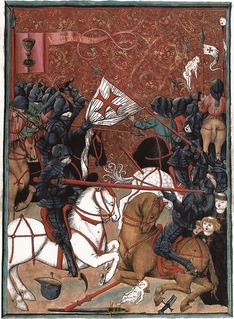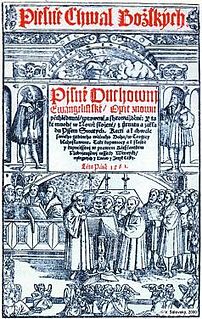 W
WThe Hussites were a Czech Proto-Protestant Christian movement that followed the teachings of reformer Jan Hus, who became the best known representative of the Bohemian Reformation.
 W
WThe Bohemian Reformation, preceding the Protestant Reformation of the 16th century, was a Christian movement in the late medieval and early modern Kingdom and Crown of Bohemia striving for a reform of the Roman Catholic Church. Lasting for more than 200 years, it had a significant impact on the historical development of Central Europe and is considered one of the most important religious, social, intellectual and political movements of the early modern period. The Bohemian Reformation produced the first national church separate from Roman authority in the history of Western Christianity, the first apocalyptic religious movement of the early modern period, and the first pacifist Protestant church.
 W
WThe Czechoslovak Hussite Church is a Christian church that separated from the Catholic Church after World War I in former Czechoslovakia.
 W
WThe Hus Congregational House, or Husův sbor, is a Hussite church in Dykova Street in Prague 10. It was completed in 1935 as part of a multi-functional development by architect Pavel Janák in the constructivist style. The tall, six-storey minimalist tower and belfry carries a 700 kg copper chalice as a symbol of the Hussite Church. The tower was briefly used to create an alternative radio station during the Prague uprising in 1945.
 W
WHuși is a city in Vaslui County, Romania, former capital of the disbanded Fălciu County in the historical region of Western Moldavia, Romanian Orthodox episcopal see, and home of some of the best vineyards of Romania. The city is located on a branch of the Iași-Galați railway, fourteen kilometres (9 mi) west of the Prut River and the border with the Republic of Moldova. In 2000, the city's population was 33,320, more than double the 1900 population of 15,404.
 W
WThe Hussite Bible is the oldest known Hungarian, as well as general Uralic Bible translation, dated to the 1420s–1430s.
 W
WThe Jistebnice hymn book is a Czech hand-written hymnbook from around 1430 and the earliest witness to a concentrated effort to translate the liturgy of the Western Church into the vernacular. It is the largest surviving compendium and the most important source of Hussite liturgy and singing in the Czech lands. It contains Czech translations of Latin liturgy, religious hymns, songs to be sung at vespers and also Czech folk Christmas carols. The manuscript is deposited in the Prague National Museum.
 W
WThe Sirotci, officially Orphans' Union, were followers of a radical wing of the Hussites in Bohemia. Founded in 1423 originally under the name Lesser Tábor, it consisted mostly of poorer burghers and some members of the lower aristocracy, who joined with commander Jan Žižka and the eastern Bohemian Hussites, the so-called Orebites (Orebité).
 W
WThe Unity of the Brethren, also known as the Evangelical Union of Behemian and Moravian Brethren and the Czech Moravian Brethren Church, is a Hussite denomination founded in 1457, whose roots are in the pre-Reformation work of Petr Chelčický and Jan Hus.
 W
WÚstí nad Orlicí is a town in the Ústí nad Orlicí District in the Pardubice Region of the Czech Republic. It has about 14,000 inhabitants. The town lies in the Orlické Mountains where the Tichá Orlice and the Třebovka rivers meet.